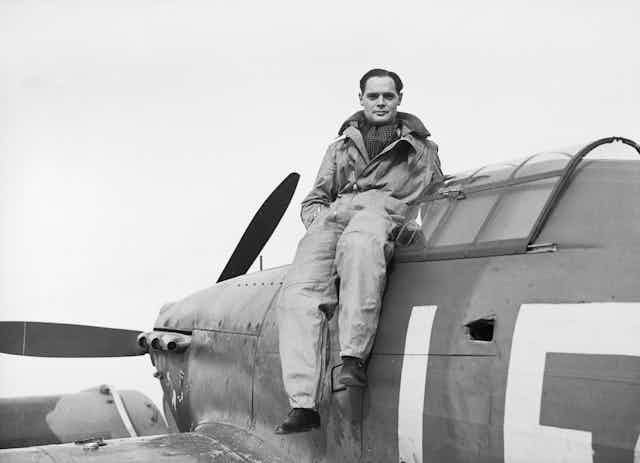In July 1940, Britain’s coalition government was concerned about public morale. German forces that had swept through France stood poised to invade. In the skies, Luftwaffe warplanes fought for the supremacy that Adolf Hitler needed to get his army across the channel. The nation’s fate hung in the balance and the Air Ministry believed uplifting stories could inspire optimism and encourage resistance.
When a 30-year-old Hurricane pilot shot down a Dornier 17 “in a fierce aerial fight”, the ministry spotted a tremendous story. This was no ordinary pilot. In 1931, he had lost both his legs when “coming out of a slow roll over Woodley Aerodrome, Reading, he crashed and for weeks struggled against death in hospital”. His legs were amputated and, although he soon learned to fly again using artificial legs, the RAF rejected his applications to return to active service until the war began.
The hero was, of course, Douglas Robert Stuart Bader (1910-1982). Today, his story is familiar to millions who have seen the award-winning film Reach for the Sky or read of his courage in books and newspapers. But in 1940, Bader was little known beyond RAF Fighter Command. In a meticulous public relations exercise, Air Ministry press officers would make him a household name.
Alerted by an Air Ministry briefing on July 14, the mass-market Conservative Daily Mail sent a reporter to interview Bader’s mother. She told the journalist: “I wish I could tell you adequately the story of how he had to face life again without two legs … It was amazing to watch his courage and the gradual return of his sunny disposition.” He had also learned how to dance and drive a car. The Mail portrayed the hero in uniform and smiling for the camera.
Thrilling tale
Like its conservative rival, the Labour-supporting Daily Mirror displayed its populist flair when it covered the story. Douglas Bader was the “Greatest hero of them all … Britain’s most amazing RAF Fighter Command Pilot”. The Mirror sent a reporter to meet the hero’s mother-in-law. Mrs Edwards said: “The more fights he can fly himself into, the better he is pleased.” He was encouraged by the love and support of her daughter Olivia, whom he married in 1938. The Mirror declared that “the story of his courage thrilled Britain”.
Establishment broadsheet The Times also got carefully targeted help. Its readers learned that Bader had “passed through Cranwell [home since 1920 of the RAF College] where he was a fine games player and captain of cricket”. The Manchester Guardian decided that its educated readers would resent mawkish populism. It noted: “Everybody who was in the Air Force or who was interested in rugby football eight or nine years ago knew DRS Bader, the Harlequins and RAF fly half, whose crash robbed him of his legs, cut short a brilliant service career and destroyed good prospects of an England cap”.
But, the report continued, Bader was not unique. Before the war an officer nicknamed “Peggy” flew “in spite of having one artificial leg. He wore a plain wooden peg-leg which he inserted into a cylindrical cigarette tin screwed to the rudder bar.”
The Daily Telegraph was not sceptical. Its correspondent, Major CC Turner, reported: “I learn that a Hurricane pilot who although he lost both his legs shot down a Dornier 17 in a weekend raid was Flying Officer DRS Bader.” Turner did not acknowledge that he had learned this from the Air Ministry. But that’s how every newspaper found out about Bader – it was a formidable work by a team determined to promote courageous young men and cheer the nation.
Naval gazing
The RAF worked closely with journalists and its reputation benefited accordingly. By contrast, the Royal Navy took a rigidly secretive approach that infuriated even the government’s chief press censor, Rear Admiral George P Thomson.
Thomson lamented that the adventures of HMS Triumph, which limped home after being damaged in action 300 miles from home, had begun on Boxing Day 1939. “Yet it was not until September 1941 that the British public were told this magnificent story of the heroism and fortitude of the British sailor.” Thomson believed secrecy had stopped people talking about the navy with pride.
The navy’s reluctance to reveal detail about the war at sea remained entrenched. In his outstanding book about journalism and conflict, The First Casualty, journalist Phillip Knightley reveals how Edward R Murrow of CBS Radio complained about the secrecy surrounding this theatre of war: “The curious thing about the Battle of the Atlantic is that no one knows anything about it. Nothing may be said either to the Americans or to the British public about this battle which, we are told, will determine the destinies of freemen for centuries.”
The thoroughly modern RAF understood that Douglas Bader was the hero Britain needed in its hour of greatest need. And such early success in promoting its achievements set a pattern that the Air Ministry would follow throughout the war. It would even invite BBC correspondents Wynford Vaughan Thomas and Richard Dimbleby to report from Lancaster Bombers flying in raids over Germany.
The army also learned to value positive reporting of its achievements when Field Marshal Montgomery presented the war in the desert to readers at home with striking phrases such as “Kill Germans, even padres – One per week day and two on Sundays”.
As for Bader, his fame did not fade when he was shot down and taken prisoner. Having received a replacement aluminium leg, dropped by parachute to his prisoner of war camp, he immediately tried to escape. A German search party found him hiding in a hayloft. After that: “They took away one of his legs every night and gave it back to him in the morning.”
Bader ended the war in the infamous Colditz castle where he was held as a member of the group known as the Prominente – famous prisoners the Nazi leadership hoped they might use as bargaining chips.

